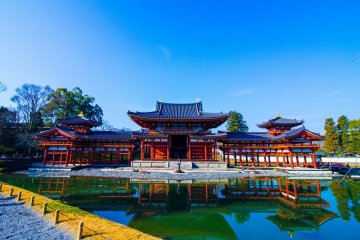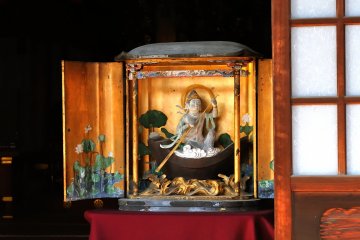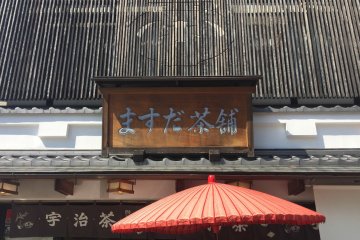
The Phoenix Hall of Byodoin in Uji
Tony MarianiThe Phoenix Hall at Byodoin Temple in Uji is the very image of Buddhist heaven.

The Byodoin Temple in the city of Uji near Kyoto adorns the reverse of the Japanese 10 yen coin and is best known for its distinctive “phoenix hall”. The original building was built in 998 as a nobleman's villa and later by a member of the then Influential Fujiwara clans acquired and converted into a temple.
Over the centuries the temple complex has been expanded and expanded, among other things, by the phoenix hall, inside of which there is an Amida Buddha statue and which thus forms the heart of the temple complex. Even if its official name is Amida Hall because of this statue, it is mainly referred to as the Phoenix Hall because of the representations of the Chinese firebird on the roof.
The Byodo-in Temple has been a UNESCO World Heritage Site since 1994 and is a popular tourist destination because of its special architecture and the surrounding garden. Visitors can also admire the interior of the hall on a guided tour.
Since 1951, the Phoenix Hall of Byodo-in has been engraved into the minds of all Japanese people — with its place on the back of the everyday 10-yen coin. The hall itself was once meant to house the regents of the Fujiwara clan, but has since been converted into a place of worship for Buddhists. Within it can be found the Amitabha Tathagata statue, a designated National Treasure of Kyoto. Look out for the two golden phoenixes atop the roof of the aptly named Phoenix Hall.
On the sprawling temple grounds is a traditional Japanese garden. Designed based on the Jodo Garden style, it is a prime example of Heian period gardens. The landscape of the garden was designed to recreate the ‘Buddhist Pure Land’, complemented by the clear Aiji-ike Pond and majestic backdrop of the surrounding mountains. Byodo-in’s garden is also the oldest remaining Jodo-style garden, and was thus enshrined as a National Historic and Scenic Beauty Site.
10-minute walk from JR Uji Station on the JR Nara Line 10-minute walk from Keihan Uji Station on the Keihan Railway Uji Line

The Phoenix Hall at Byodoin Temple in Uji is the very image of Buddhist heaven.

The Byōdō-in Temple as represented on the Japanese 10 yen coin can still be seen and visited today.

Enjoy the beauty of renewed Byodo-in Phoenix Hall in Uji City, Kyoto, after a two-year renovation!

There are other temples inside the premises of Byodo-in Temple Complex in Uji City in Kyoto. Don't forget to visit them when you come to see the newly renovated Phoenix Hall!

Byodo-in could arguably be called the Sistine Chapel of Japanese temple art & architecture. The Phoenix Hall's Amida Buddha was created by Jocho, a prominent sculptor.

Views of Byodo-in at Uji, taken from the path outside the temple grounds, with tiled roof tops rising above green trees.

This is the place where Ryoma Sakamoto was attacked by authorities. His wife Oryo saved him by running naked from the bath to inform him of the coming danger!

Uji is thought to be the first place in Japan to have mastered tea growing. Thus, it makes sense that Uji is so well-known for matcha. Masuda Tea Store is about a fifteen to twenty-minute walk from JR Uji station and is located right across from the main gate entrance to Byodoin Temple - the temple most people would recognize as the building on the 10 yen coin.

Visiting the Kansai region and wanting to try one of the signature dishes of Western Japan, “Okonomiyaki?” Or, have you already tried and loved the dish in Hiroshima, but are craving the delicate flavor of bonito flakes, grilled cabbage, soft and tender pork strips, and maybe even grilled octopus if you’re feeling for the flavor adventure? Look no further than NoBoRi (のぼり in Fushimi, Kyoto.

Torikizoku is a popular and affordable yakitori chain store in Japan. What is yakitori? Yakitori is grilled chicken served on wooden skewers in a variety of flavors - teriyaki, spiced salt, spicy, and more. Torikizoku serves extremely tender “Momo Yakitori,” which is the signature chicken meat skewer of many yakitori restaurants, and is a favorite for fans from around the world.

Located in Uji, the city renowned for green tea, Ujigami shrine is Japan’s oldest existing shrine. Among the country’s thousands of shrines, Ujigami shrine was one of the first — allegedly built during the year 1060. Although the shrine is rather off the beaten track, its convenient location makes it easy to combine visits with nearby Byodo-in Temple and Uji-gawa Shrine. Ujigami-jinja’s grounds are quiet and serene, located away from the bustling tourist attractions in central Kyoto. It was originally built to honor Emperor Ojin and his sons, after one of the princes committed suicide in a selfless effort to solve the dispute over imperial succession. Now, Ujigami shrine also serves as the guardian shrine for Byodo-in Temple. Visitors to Ujigami-jinja will also notice the abundance of rabbit motifs. The puzzling presence of rabbits is related to a myth about a divine rabbit that guided the lost prince back to town. Since then, the rabbit has been honored in the form of figurines, omikuji and more in the city of Uji. The temple’s springwater is said to have special qualities, making it the best choice for use in traditional tea ceremonies — rated to be among the 'Seven best waters of Uji'. Its main Honden building is also believed to be the oldest remaining example of nagare-zukuri-style architecture. Being host to such historically significant sites, it is no wonder that Ujigami-jinja was designated a UNESCO World Heritage Site in 1994.

The Nintendo Museum in Uji City, Kyoto, offers a rare chance to explore the full legacy of one of Japan’s most influential entertainment companies. Whether you're a lifelong fan of Mario, Zelda, Pokémon, and other beloved Nintendo franchises or simply curious about how gaming has evolved over the years, this museum offers a hands-on look into the creative history behind it all. Housed in the former Nintendo Uji Ogura Plant, the museum has been thoughtfully renovated into a modern, visitor-friendly space. The interior has been redesigned for access and accessibility while much of the entire building's original character has been preserved. Inside, you’ll find a wide-ranging showcase of the entertainment Nintendo has created since its founding in September 1889—from traditional Hanafuda playing cards to the latest Nintendo Switch. Exhibits are arranged by era on the second floor of Exhibition Building 1, allowing visitors to follow Nintendo’s story from past to present. Across several themed zones, you can view side-by-side displays of early toys, classic handhelds, and home consoles that helped shape the gaming world. Iconic systems like the Famicom (NES), Game Boy, and Nintendo 64 are on display in excellent condition. Each exhibit is accompanied by easy-to-follow visuals in both English and Japanese, along with interactive features that let you explore Nintendo’s legacy at your own pace. Another highlight of the museum is the Unique Play Experiences area on the first floor of Exhibition Building 1. This zone features interactive exhibits that capture Nintendo’s signature blend of creativity and innovation—including games that use oversized controllers and play out on giant screens. Each visitor receives 10 digital coins upon entry, which can be used to access selected exhibits. Since each activity requires a different number of coins, you’ll need to choose carefully—adding a light strategic element to your visit, much like playing a Nintendo game itself. After exploring the interactive exhibits, visitors looking for a more hands-on, creative experience can join the craft workshop. Here, you’ll create your own Hanafuda playing cards. Once your set is complete, you’ll also learn the rules and have a chance to play the game. This experience requires a same-day reservation and an additional fee, so be sure to plan ahead if you’d like to take part. Ticket information A visit to the Nintendo Museum takes about 1.5 to 2 hours, and you’ll need to plan ahead as same-day admission isn’t available at the moment. Tickets are offered through a lottery system, and you can apply up to three months before your visit using a free Nintendo Account. If your entry gets selected, make sure to pay by the 7th of the following month using a credit card. You’ll get an email with the results, but you can also check the ticketing site. Further, your QR code ticket will be ready to download from 2pm the day before your visit. On the day itself, don’t forget to bring your QR code and a valid ID. If you’re not a Japanese national, your passport is required. Once your code is scanned and you pass through security, you’ll get your official play ticket. If you bought tickets for friends or family, you can assign them their own QR codes too, as long as they have Nintendo Accounts. The ticketing system is a bit of a process, but the visit offers a fun and nostalgic dive into Nintendo’s world—something many fans find well worth the effort.

Ōbaku-san Manpuku-ji is a temple located in Uji, Kyoto. It is the head temple of the Japanese Ōbaku Zen sect, named after Wanfu Temple in Fujian, China. The mountain is likewise named after Mount Huangbo, where the Chinese temple is situated. [Wikipedia]